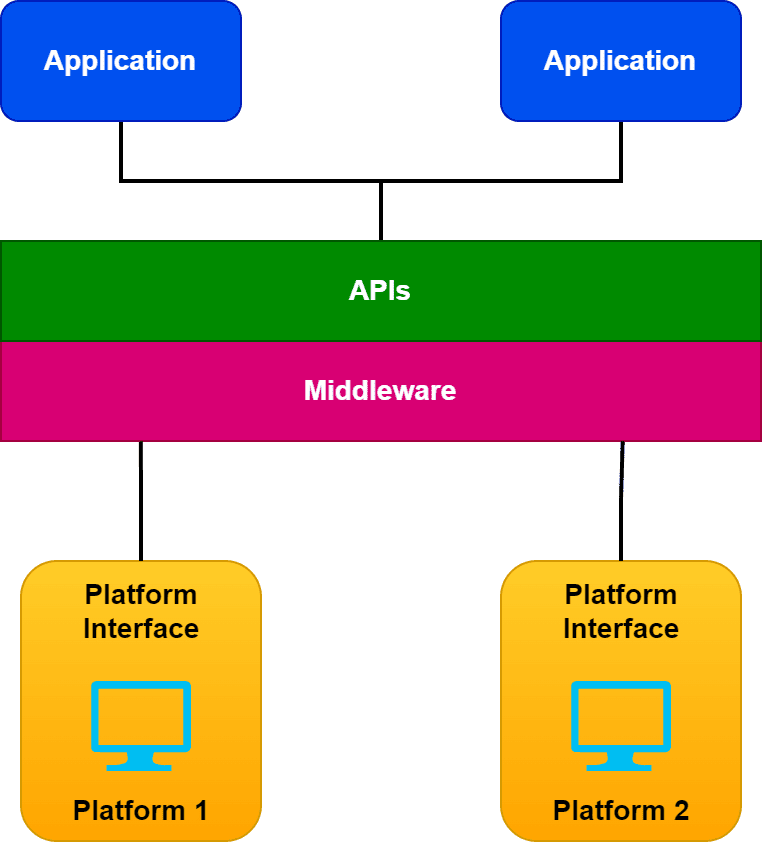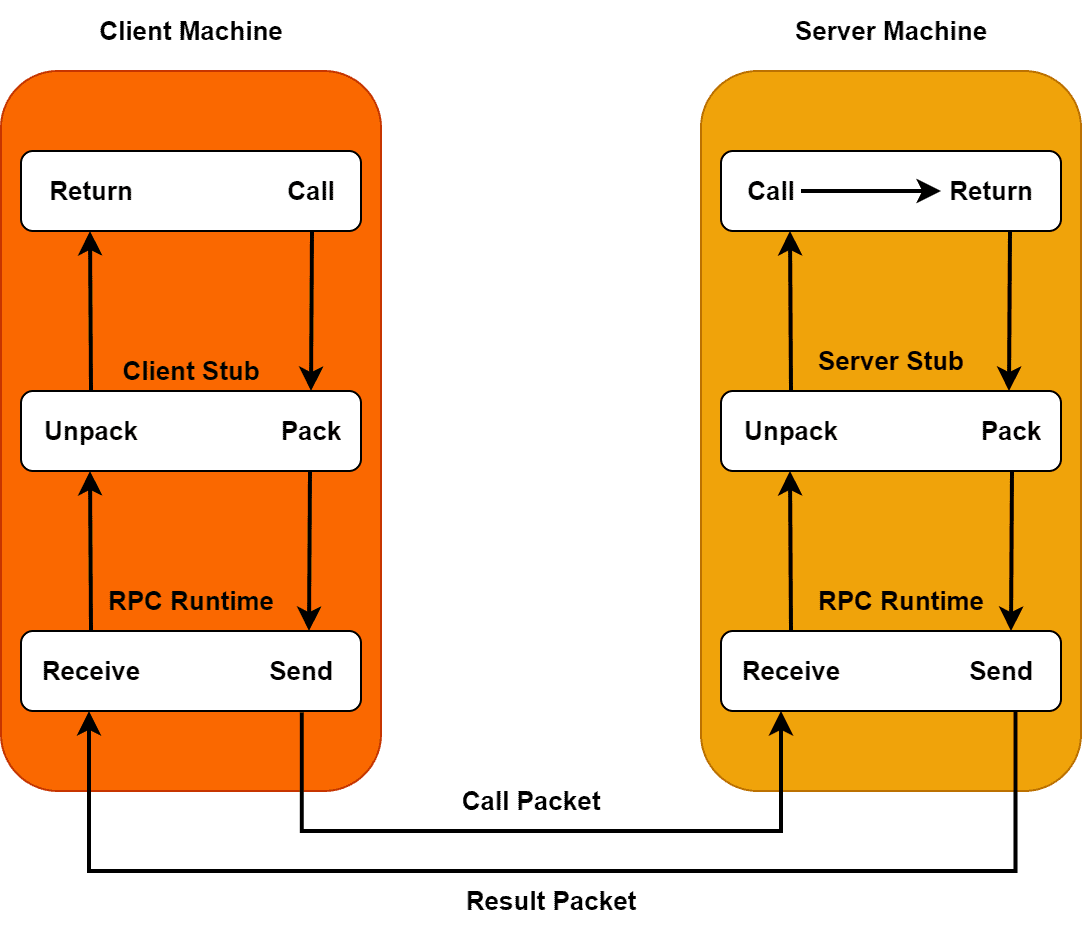Learn through the super-clean Baeldung Pro experience:
>> Membership and Baeldung Pro.
No ads, dark-mode and 6 months free of IntelliJ Idea Ultimate to start with.
Last updated: March 18, 2024
In this tutorial, we’ll discuss the basic concept behind middleware. Furthermore, we’ll explore different types of middleware.
Finally, we’ll highlight some crucial advantages and disadvantages of it.
Middleware refers to software that sits between different systems, applications, and components. Additionally, it acts as a bridge to facilitate communication and data exchange between them. Furthermore, we often use middleware in conjunction with web frameworks and APIs. As a result, it improves web applications’ scalability and maintainability. Let’s take a look at the architecture of middleware:

Middleware often provides several services, such as message queuing, authentication, and data transformation. By providing a standardized interface and abstracting away the complexity of the underlying systems, middleware can help to simplify the development of complex distributed systems.
In web development, middleware is a type of software we use between the client and the server. Additionally, it plays a vital role in handling requests and responses. Furthermore, middleware can intercept and process incoming requests before passing them on to the server. Similarly, they can process outgoing responses before returning them to the client.
We commonly use middleware in software development, where we need to add additional functionality to an application or system without modifying its core code.
There’re several types of middleware. We can classify them based on their function and usage in the software stack. We’ll discuss six types of commonly used middleware:

We use application middleware in web applications to handle HTTP requests and responses. Additionally, we can utilize them for tasks such as authentication, logging, and error handling. Examples of application middleware include Express.js, Django framework, Apache Tomcat, and Microsoft IIS.
Integration middleware is used to connect different systems or applications together. Furthermore, it provides an abstraction layer between them, allowing them to communicate and exchange data seamlessly. Examples of integration middleware include the enterprise service bus (ESB), message queueing systems, and API gateways.
The third type of middleware is database middleware. Furthermore, it provides a layer of abstraction between the application and the database, allowing the application to interact with the database without needing to know the details of its implementation. Additionally, it facilitates additional features such as caching and replication. Examples of database middleware are Oracle GoldenGate, MySQL Replication, and DBCP.
In order to manage resources and provide services to applications running on top of the operating system, we can use operating system middleware. Examples include middleware for managing files, processes, and network connections.
Furthermore, to enable communication between different applications or components using messages, we utilize messaging middleware. It provides features such as message queuing, routing, and transformation. Examples of messaging middleware include Apache Kafka and RabbitMQ.
Finally, security middleware provides security features such as encryption, decryption, authentication, and authorization. Additionally, we can use them to secure web applications, APIs, and other systems. Examples of security middleware include SSL/TLS and OAuth.
Now let’s take an example of middleware and explore how it works.
We can utilize the remote procedure call (RPC) middleware when working in a distributed computing environment. It’s a protocol that enables a client application to invoke a procedure or method on a remote server application. Now let’s see how RPC works:

First, the client application makes an RPC request to the server application. Additionally, this request includes the name of the function to be executed, input parameters, and necessary authentication credentials. Furthermore, the client’s RPC library packs the request into a format that can be transmitted over the network, such as XML or JSON. In order to initiate the transfer, the client executes the client stub procedure.
We generally send the request over the network to the server application using a transport protocol such as TCP or HTTP. Further, the server’s RPC library receives the request, unpacks the request into a format that the server can understand, and checks the authentication credentials.
Moving forward, the server application executes the requested function using input parameters provided in the request. Therefore, the server’s RPC library packs the results of the function into a format that can be transmitted over the network. Furthermore, the response is sent over the network to the client application.
The client’s RPC library unpacks the response into a format the client can understand. Finally, the client application receives the response and processes the results of the function or method call.
Let’s talk about the advantages and disadvantages of middleware:
| Advantages | Disadvantages |
|---|---|
| Provides an abstraction layer between different systems and components | Requires additional infrastructure, configuration, and maintenance. Hence, it adds complexity |
| Easier to scale up or down the infrastructure to meet changing needs without causing disruptions | Introduces performance overhead, as it adds an additional layer of processing and communication between different systems or components |
| Improves communication between different applications by providing a common language and interface | It can be expensive, especially if it requires custom development or additional hardware |
| Provides flexibility to organizations by enabling them to integrate new technologies without having to change their existing infrastructure | Creates vendor lock-in, as applications and systems become dependent on specific middleware products |
| Helps organizations save money by reducing the need for custom development and simplifying the integration process | Creates integration challenges, particularly when different systems or components use different middleware products |
| Provides security features such as encryption, authentication, and authorization to protect data from unauthorized access | Poorly designed middleware can impact system performance, leading to latency and bottlenecks |
| Provides high levels of availability and reliability, reducing the risk of downtime | Maintaining and upgrading can be time-consuming and costly |
| Reduces manual effort and automates many routine tasks | May not be compatible with all existing applications and systems, requiring additional customization |
In this tutorial, we discussed the basic concept of middleware, along with an example. We explored different types of middleware. Finally, we highlighted some crucial advantages and disadvantages of middleware.